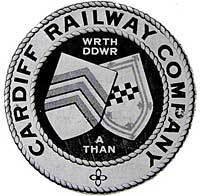
Cardiff Railway
Encyclopedia

Taff Vale Railway
The Taff Vale Railway is a railway in Glamorgan, South Wales, and is one of the oldest in Wales. It operated as an independent company from 1836 until 1922, when it became a constituent company of the Great Western Railway...
and the Rhymney Railway
Rhymney Railway
The Rhymney Railway was virtually a single stretch of main line, some fifty miles in length, by which the Rhymney Valley was connected to the docks at Cardiff in the county of Glamorgan, South Wales.-History:...
, inter alia, with access.
On 6 August 1897 the Bute Docks Company became the Cardiff Railway Company, and the line between Heath Junction and Treforest was opened. This opening was filled with difficulties, because Treforest Junction was on the Taff Vale Railway, at the same point as the TVR's junction with the Barry Railway. Here the Barry syphoned off large amounts of coal traffic for transport to Barry Docks. The TVR had no intention of allowing more to be syphoned off by another company, and so it defied the Act of Parliament which had authorised the junction and appealed against its opening on the grounds that it was unsafe.
A delay of some years was followed by an agreement over the design of the junction and the successful running of a ceremonial opening train, which was promptly followed by the TVR, with the support of the Barry, removing the junction; again on the grounds that it was unsafe. It was obvious to all concerned that the TVR was deliberately attempting to crush this rival before it became too big, but little could be done about their petty objections - particularly as the junction was on their railway. Regular coal trains never used the junction, as the Cardiff Railway gave up the battle at this point and suggested a merger between it, the TVR, and the Rhymney Railway. Although both companies involved agreed with this, the Barry and Pontypridd, Caerphilly and Newport Railway objected on the grounds of unfair competition, particularly as the TVR was one of the world's most profitable railways (although the Barry was a close second).
Ultimately the Cardiff was forced to acknowledge that it would never be a successful company in its own right, but remained independent until the Railways Act 1921
Railways Act 1921
The Railways Act 1921, also known as the Grouping Act, was an enactment by the British government of David Lloyd George intended to stem the losses being made by many of the country's 120 railway companies, move the railways away from internal competition, and to retain some of the benefits which...
, when it became a constituent part of the Great Western Railway
Great Western Railway
The Great Western Railway was a British railway company that linked London with the south-west and west of England and most of Wales. It was founded in 1833, received its enabling Act of Parliament in 1835 and ran its first trains in 1838...
on 1 January 1922.
Locomotives
The Cardiff Railway had 36 steam locomotives, all built by private manufacturers, which were acquired by the GWR on 1 January 1922. For details see Locomotives of the Great Western Railway#Cardiff RailwaySee also
- The Cardiff Railway by Eric Mountford. Published by Oakwood Press.
- Pierhead BuildingPierhead BuildingThe Pierhead Building is a Grade 1 listed building of the National Assembly for Wales in Cardiff Bay, Wales. It stands as one of the city of Cardiff's most familiar landmarks and was built in 1897 as the headquarters for the Bute Dock Company....

